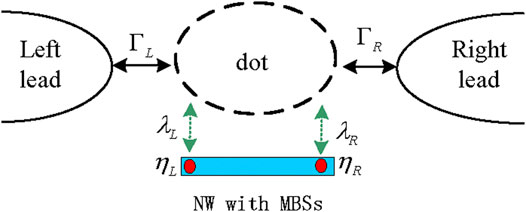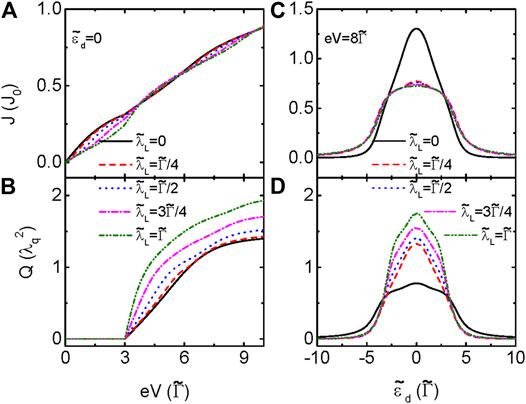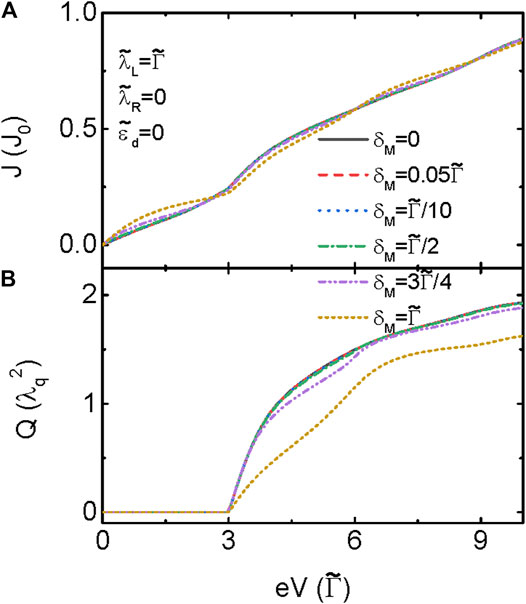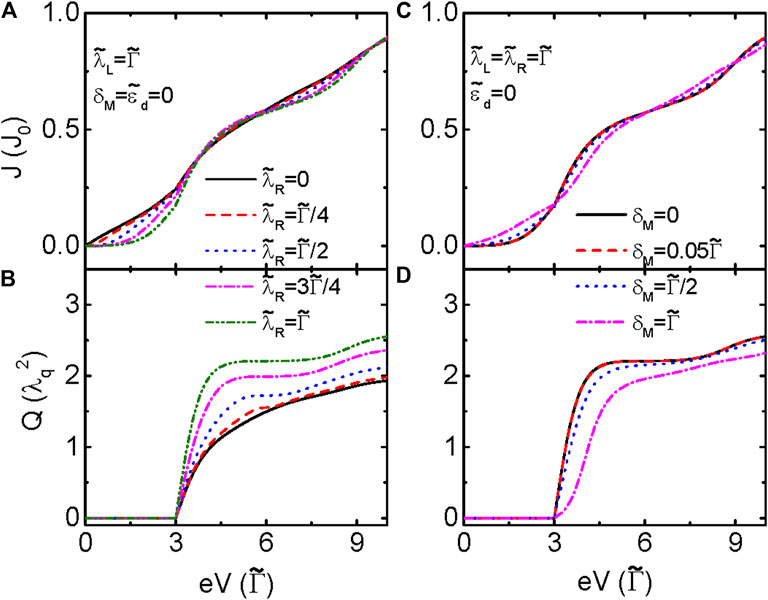- College of Physics and Electromechanics, Fujian Longyan University, Longyan, China
Heat current generated by electronic transport through a quantum dot (QD) coupled to both a phonon bath and a Majorana nanowire hosting Majorana bound states (MBSs) is theoretically studied in the framework of non-equilibrium Green’s function technique. The calculated numerical results show that electrical current can be either enhanced or suppressed by the combined influences of the phonon bath and the MBSs at certain bias voltage regimes. The enhancement and suppression of the current’s magnitude for a fixed bias voltage will be reversed due to the direct hybridization between the MBSs. The simultaneous coupling between both MBSs will amplify the function of the MBSs on the current, with the same unchanged and essential qualitative impacts. Heat generation by the electrical current can be fully adjusted by the dot–MBS coupling, direct hybridization between the MBSs, and positions of the dot level. By properly choosing the above parameters, heat generation can be suppressed even for increased electrical current, which is favorable in removing waste heat generated by electrical current flowing through low-dimensional circuits.
1 Introduction
With continuing decreased size and increased density of electronic devices integrated in circuits, the issue of heat generation by electrical current becomes progressively vital. In mesoscopic and nanoscale systems, heat is mainly generated from electron–phonon interaction (EPI), by which the energy accompanying the electric current flowing through the scattering region is transferred to the phonon bath as heat. In fact, recent progresses in nano-fabrication and characterization have brought about a new subject of phononics, which is interested in carrying heat current and information by phonons in addition to electrons or photons [1, 2]. Similar to the case in the usual electronics, the elementary unit in phononics is the preparation, detection, and manipulation of the thermal diode and memory devices. The thermal diode is to switch on–off or to amplify heat current [3, 4], and the thermal memory devices are building blocks for a quantum computer in terms of phonons [5, 6]. Up to now, phononics is still in its primary stage in that the movement of phonons is quite difficult to be controlled, which is contrary to the case of electrons. This is mainly because those phonons are quasiparticles behaving as energy elements without either bare mass or charge [1, 2], which is totally different from the characteristics of electrons. In addition, there are no interactions between single phonon modes. Thus, understanding the nature and controlling the movement of phonons with the help of EPI has become a much interesting research subject, and many theoretical and experimental works about phonon-assisted tunneling through low-dimensional systems have been performed [2–10].
Very similar to the characteristics of phonons, another quasiparticle known as Majorana bound states (MBSs) with zero mass and charge has recently been extensively studied both theoretically and experimentally [11]. The MBSs are of their own antiparticles having no energy and have been successfully formed in various platforms, including superconductors with a non-centrosymmetric center [12, 13], topological insulators in proximity to superconductors [14], defects located in topological superconductors [15], and p-wave superconductors [16]. They are also realizable even in the semiconductor [17] or ferromagnetic [18] nanowires having strong spin–orbit interaction or Josephson junctions [19]. They are very promising in both fault-tolerant quantum computation and energy conservation electronic setups. In line with the preparation of MBSs, their detection is also an important task due to the unique zero-energy, chargeless, and massless nature. Motivated by this, many detection schemes for the existence of MBSs have been proposed, among which the most important one is the electrical transport spectroscopy which applies an electric field on the setup having MBSs and then detects the associated electrical current. The MBS induces an abnormal zero-bias peak in the differential conductance, by which the existence of MBSs can be deduced [20, 21]. This zero-bias peak in the differential conductance, however, can also be induced by other mechanisms, such as the Kondo effect [16] and Andreev bound states [20]. Some other schemes, for example, the unusual sign change or enhancement of thermopower by MBSs, were proposed recently [22–24]. Moreover, a semiconductor quantum dot (QD) side-coupled to MBSs and sandwiched between leads was also introduced to break electron–hole symmetry to avoid null thermoelectric signatures. A previous work shows that the sign change induced by changes in the dot level, dot–MBS coupling strength, and direct MBS–MBS coupling are an efficient demonstration of MBSs. The thermoelectric effect assisted by MBSs was studied in structures composed of a QD connected to more than one lead. Moreover, universal Majorana thermoelectric noise in such similar systems was proposed as a non-invasive electrical detection scheme for the MBSs [24]. Optical detection schemes were also put forward in recent years [25–28]. For example, Liu et al. demonstrated that MBSs will absorb and emit photons and then induce photon-assisted side band in the conductance, which can split the MBSs and result in a novel non-zero MBS mode. This provides a new detection means for the MBSs which are very different from the previously proposed ones [25]. All-optical detecting plans for the MBSs were put forward by Zhu et al. [26] relying on a QD coupled to nanomechanical resonators, and they found that the optical signatures are enhanced by MBSs. Tang et al. [29] have proved that the existence of MBSs will induce a sign change of the tunnel magnetic resistance, which measures the relative change in the electronic currents when the magnetic moments of two leads are changing from parallel to antiparallel configurations.
Heat generation by electrical current in universal nanostructures was theoretically investigated by Sun et al. by the non-equilibrium Keldysh Green’s function method [30], in which the heat originates from the EPI. The authors proved that the behaviors of the heat current in low-dimensional systems are quite different from Joule’s law valid in macroscopic structures. This issue then arouse many investigations [31–33], and it was found that phonon emission processes occur if the Coulomb repulsion equals the phonon energy and induces a high peak in heat generation at even a small electric current [32]. By changing the energy levels in the QD, the heat current decreases regardless of increased electrical bias voltage as the electrons emit phonons in this process. This may induce a negative differential of heat generation [32]. If the scattering region is under a temperature difference between its two ends, it was found that the electrons tunneling through the dot will absorb heat current from the phonon bath to the scattering region and then serve as a nano-refrigerator [32, 33]. In view of the similarities between phonons and MBSs, here we study electrical current and heat exchanged between electrons passing through a QD and a phonon bath interacting with the QD under the influence of a Majorana nanowire hosting MBSs (see Figure 1). Our results show that both the electrical current and heat generation can be fully adjusted by the existence of MBSs. Under some conditions, the electrical current can be enhanced with small heat generation, which is useful in energy-saving devices.

FIGURE 1. Plot of a quantum dot connected to MBSs prepared at the ends of a topological superconductor nanowire. The dot is coupled to the left and right leads and to a phonon bath with phonon frequency
2 Model and Methods
The Hamiltonian of the considered system composed of a semiconductor QD coupled to two leads and a Majorana nanowire is written as follows (
where the first term is for the left (
where the operator
We then perform a canonical transformation to eliminate the electron–phonon coupling, that is, [30–32]
where the dot level is transformed into
where
where
3 Results and Discussion
In this section, we present our numerical results of heat generation Q and electrical current J versus either the bias voltage

FIGURE 2. Electrical current (A) and heat generation (B) as functions of the bias voltage for
When the dot is hybridized to the MBSs formed at the left side of the nanowire (
In real experiments, the two modes of the MBSs formed at different ends of a nanowire interact with each other with an amplitude of

FIGURE 3. (A) Electrical current and (B) heat generation as functions of the bias voltage at different
If both ends of the nanowire are close to the QD [34, 35], the MBSs prepared may couple to the dot simultaneously. In 2011, Flensberg proposed a scheme composed of a QD that couples to both modes of the MBSs to implement a

FIGURE 4. Electrical current and heat generation (A, B) as functions of the bias voltage and (C, D) vs the dot level at different values of
4 Summary
In summary, the present paper studies electric transport and heat generation in a QD side-coupled to MBSs formed at opposite ends of a topological nanowire. It is found that the amplitude of the phonon-assisted current can be either enhanced or suppressed depending on the value of bias voltage compared to the phonon energy. If the dot is simultaneously coupled to the two isolated modes of the MBSs, the change in the current becomes more obvious, but it essentially resembles the case when it is coupled to only one mode of the MBSs. The direct overlap between the MBSs will totally reverse the functions of the MBSs on the current’s magnitude, which is individually enhanced and suppressed by hybridization between the MBSs in the bias regimes between which the current is suppressed and enhanced when the dot is only coupled to one isolated mode of the MBSs. The magnitude of heat generation is monotonously enhanced when the dot is coupled to either one or both of the isolated MBSs, whereas it is monotonously suppressed in the presence of direct overlap between the two MBSs. The variation of the electrical current and heat generation due to the MBSs enables the possibility of simultaneously enhancing the current while suppressing the generated heat and is ideal in designing energy conservation devices.
Data Availability Statement
The original contributions presented in the study are included in the article/supplementary material, and further inquiries can be directed to the corresponding author.
Author Contributions
ZW derived the formulae, performed the numerical calculations, and wrote the original manuscipt.
Funding
This work was supported by the thirteenth five-year plan of educational science in Fujian Province (Grant No. 2019CG0707).
Conflict of Interest
The author declares that the research was conducted in the absence of any commercial or financial relationships that could be construed as a potential conflict of interest.
References
1. Li NB, Ren J, Wang L, Zhang G, Hanggi P, Li BW. Colloquium: Phononics: Manipulating Heat Flow with Electronic Analogs and Beyond. Rev Mod Phys (2012) 84:1045–66. doi:10.1103/RevModPhys.84.1045
2. Balandin AA. Nanophononics: Phonon Engineering in Nanostructures and Nanodevices. J Nanosci Nanotech (2005) 5:1015–22. doi:10.1166/jnn.2005.175
3. Liang B, Yuan B, Cheng J-c. Acoustic Diode: Rectification of Acoustic Energy Flux in One-Dimensional Systems. Phys Rev Lett (2009) 103:104301. doi:10.1103/PhysRevLett.103.104301
4. Li B, Wang L, Casati G. Thermal Diode: Rectification of Heat Flux. Phys Rev Lett (2004) 93:184301. doi:10.1103/PhysRevLett.93.184301
5. Xie R, Bui CT, Varghese B, Zhang Q, Sow CH, Li B, et al. An Electrically Tuned Solid-State Thermal Memory Based on Metal-Insulator Transition of Single-Crystalline VO2 Nanobeams. Adv Funct Mater (2011) 21:1602–7. doi:10.1002/adfm.201002436
6. Dubi Y, Di Ventra M. Colloquium: Heat Flow and Thermoelectricity in Atomic and Molecular Junctions. Rev Mod Phys (2011) 83:131–55. doi:10.1103/RevModPhys.83.131
7. Chen Z-Z, Lü R, Zhu B-f. Effects of Electron-Phonon Interaction on Nonequilibrium Transport through a Single-Molecule Transistor. Phys Rev B (2005) 71:165324. doi:10.1103/PhysRevB.71.165324
8. Balandin A, Wang KL. Significant Decrease of the Lattice thermal Conductivity Due to Phonon Confinement in a Free-Standing Semiconductor Quantum Well. Phys Rev B (1998) 58:1544–9. doi:10.1103/PhysRevB.58.1544
9. Shamsa M, Liu W, Balandin AA, Liu J. Phonon-hopping thermal Conduction in Quantum Dot Superlattices. Appl Phys Lett (2005) 87:202105. doi:10.1063/1.2130711
10. Rego LGC, Kirczenow G. Quantized thermal Conductance of Dielectric Quantum Wires. Phys Rev Lett (1998) 81:232–5. doi:10.1103/PhysRevLett.81.232
11. Fu L, Kane CL. Superconducting Proximity Effect and Majorana Fermions at the Surface of a Topological Insulator. Phys Rev Lett (2008) 100:096407. doi:10.1103/PhysRevLett.100.096407
12. Alicea J, Oreg Y, Refael G, von Oppen F, Fisher MPA. Non-abelian Statistics and Topological Quantum Information Processing in 1d Wire Networks. Nat Phys (2011) 7:412–7. doi:10.1038/nphys1915
13. Karzig T, Knapp C, Lutchyn RM, Bonderson P, Hastings MB, Nayak C, et al. Scalable Designs for Quasiparticle-Poisoning-Protected Topological Quantum Computation with Majorana Zero Modes. Phys Rev B (2017) 95:1–32. doi:10.1103/PhysRevB.95.235305
14. Sato M, Fujimoto S. Topological Phases of Noncentrosymmetric Superconductors: Edge States, Majorana Fermions, and Non-abelian Statistics. Phys Rev B (2009) 79:1–16. doi:10.1103/PhysRevB.79.09450410.1103/physrevb.79.094504
15. Qi X-L, Zhang S-C. Topological Insulators and Superconductors. Rev Mod Phys (2011) 83:1057–110. doi:10.1103/RevModPhys.83.1057
16. Wang R, Su W, Zhu J-X, Ting CS, Li H, Chen C, et al. Kondo Signatures of a Quantum Magnetic Impurity in Topological Superconductors. Phys Rev Lett (2019) 122:1–6. doi:10.1103/PhysRevLett.122.087001
17. Mourik V, Zuo K, Frolov SM, Plissard SR, Bakkers EPAM, Kouwenhoven LP. Signatures of Majorana Fermions in Hybrid Superconductor-Semiconductor Nanowire Devices. Science (2012) 336:1003–7. doi:10.1126/science.1222360
18. Choy T-P, Edge JM, Akhmerov AR, Beenakker CWJ. Majorana Fermions Emerging from Magnetic Nanoparticles on a Superconductor without Spin-Orbit Coupling. Phys Rev B (2011) 84:1–6. doi:10.1103/PhysRevB.84.195442
19. San-Jose P, Prada E, Aguado R. Ac Josephson Effect in Finite-Length Nanowire Junctions with Majorana Modes. Phys Rev Lett (2012) 108:1–5. doi:10.1103/PhysRevLett.108.257001
20. Ricco LS, de Souza M, Figueira MS, Shelykh IA, Seridonio AC. Spin-dependent Zero-Bias Peak in a Hybrid Nanowire-Quantum Dot System: Distinguishing Isolated Majorana Fermions from Andreev Bound States. Phys Rev B (2019) 99:1–9. doi:10.1103/PhysRevB.99.155159
21. Liu C-X, van Heck B, Wimmer M. Josephson Current via an Isolated Majorana Zero Mode. Phys Rev B (2021) 103:1014510. doi:10.1103/PhysRevB.103.014510
22. López R., Lee M., Serra L., Lim J. S. Thermoelectrical detection of majorana states. Phys Rev B (2014) 89:1–7. doi:10.1103/PhysRevB.89.205418
23. Ricco LS, Dessotti FA, Shelykh IA, Figueira MS, Seridonio AC. Tuning of Heat and Charge Transport by Majorana Fermions. Sci Rep (2018) 8:2790–7. doi:10.1038/s41598-018-21180-9
24. Smirnov S. Universal Majorana Thermoelectric Noise. Phys Rev B (2018) 97:1–14. doi:10.1103/PhysRevB.97.165434
25. Tang H-Z, Zhang Y-T, Liu J-J. Photon-assisted Tunneling through a Topological Superconductor with Majorana Bound States. AIP ADVANCES (2015) 5:1–8. doi:10.1063/1.4939096
26. Chen H, Zhu K. All-optical Scheme for Detecting the Possible Majorana Signature Based on Qd and Nanomechanical Resonator Systems. Sci China Phys Mech Astron (2015) 58:1–14. doi:10.1007/s11433-014-5637-4
27. Väyrynen JI, Rastelli G, Belzig W, Glazman LI. Microwave Signatures of Majorana States in a Topological Josephson junction. Phys Rev B (2015) 92:1345081–5. doi:10.1103/PhysRevB.92.134508
28. Chi F, He T-Y, Wang J, Fu Z-G, Liu L-M, Liu P, et al. Photon-assisted Transport through a Quantum Dot Side-Coupled to Majorana Bound States. Front Phys (2020) 8:2541–7. doi:10.3389/fphy.2020.00254
29. Tang L-W, Mao W-G. Detection of Majorana Bound States by Sign Change of the Tunnel Magnetoresistance in a Quantum Dot Coupled to Ferromagnetic Electrodes. Front Phys (2020) 8:1471–8. doi:10.3389/fphy.2020.00147
30. Sun Q-f., Xie XC. Heat Generation by Electric Current in Mesoscopic Devices. Phys Rev B (2007) 75:155306. doi:10.1103/PhysRevB.75.155306
31. Liu J, Song J, Sun Q-f., Xie XC. Electric-current-induced Heat Generation in a Strongly Interacting Quantum Dot in the Coulomb Blockade Regime. Phys Rev B (2009) 79:161309. doi:10.1103/PhysRevB.79.161309
32. Chi F, Zheng J, Liu Y-S, Guo Y. Refrigeration Effect in a Single-Level Quantum Dot with thermal Bias. Appl Phys Lett (2012) 100:233106. doi:10.1063/1.4720093
33. Chi F, Sun L-L. Photon-assisted Heat Generation by Electric Current in a Quantum Dot Attached to Ferromagnetic Leads. Chin Phys. Lett. (2016) 33:1–6. doi:10.1088/0256-307X/33/11/117201
34. Liu DE, Baranger HU. Detecting a Majorana-Fermion Zero Mode Using a Quantum Dot. Phys Rev B (2011) 84:201308R. doi:10.1103/PhysRevB.84.201308
35. Prada E, Aguado R, San-Jose P. Measuring Majorana Nonlocality and Spin Structure with a Quantum Dot. Phys Rev B (2017) 96:085418. doi:10.1103/PhysRevB.96.085418
36. Deng MT, Vaitiekenas S, Prada E, San-Jose P, Nygard J, Krogstrup P, et al. Nonlocality of Majorana Modes in Hybrid Nanowires. Phys Rev B (2018) 98:085125. doi:10.1103/physrevb.98.085125
Keywords: quantum dot, phonon, Majorana bound states, electrical current, heat generation
Citation: Wang Z-H (2021) Heat Generation by Electrical Current in a Quantum Dot Hybridized to Majorana Nanowires. Front. Phys. 9:704493. doi: 10.3389/fphy.2021.704493
Received: 03 May 2021; Accepted: 27 May 2021;
Published: 22 June 2021.
Edited by:
Feng Chi, University of Electronic Science and Technology of China, ChinaReviewed by:
Jia Liu, Inner Mongolia University of Science and Technology, ChinaXiu Qing Wang, Inner Mongolia University for Nationalities, China
Copyright © 2021 Wang. This is an open-access article distributed under the terms of the Creative Commons Attribution License (CC BY). The use, distribution or reproduction in other forums is permitted, provided the original author(s) and the copyright owner(s) are credited and that the original publication in this journal is cited, in accordance with accepted academic practice. No use, distribution or reproduction is permitted which does not comply with these terms.
*Correspondence: Zhu-Hua Wang, bHl3emg2NjZAMTYzLmNvbQ==
 Zhu-Hua Wang
Zhu-Hua Wang